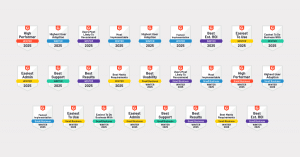Contract negotiations can shape the success of a project long before any work begins. For architects and engineers, the right terms safeguard your business, your team, and your client relationships. But knowing what’s worth negotiating and what should stay firm is key to avoiding disputes later on.
In this interview, Lincoln Merlo, Executive Director and Engineer at erbas™ | erbas™ SUSTAIN and member of the Blueprint Collective, shares practical, experience-based advice on what’s negotiable, common contract pitfalls, and how firms can protect themselves while keeping discussions professional and collaborative.
What’s worth negotiating in A&E contracts?
LM: When you step into contract talks, focus on the areas that genuinely improve outcomes for your business and the client. A few key ones are:
Payment terms: Things like invoicing schedules, progress payment milestones, and interest on late payments can usually be adjusted to suit both parties. These are often the easiest wins and can improve cash flow without impacting project outcomes.
Delivery timelines: Unrealistic deadlines only create stress and risk for both sides. Clarifying achievable milestones upfront helps set realistic expectations and avoids painful disputes later.
Small changes to wording for clarity: Poorly written or vague contracts frequently cause problems mid-project. Undefined deliverables, unclear variation processes, or assumptions about responsibilities often lead to delays, unpaid work, and even fee disputes. If something could cause confusion later, make sure it is spelled out in the contract. The upfront effort always pays off.
What should never be up for negotiation?
LM: Anything that compromises safety, compliance, or your professional duty of care should never be negotiable. These obligations protect lives and are non-negotiable from both a legal and ethical perspective.
Limiting your liability is also critical. Accepting unlimited risk or fitness for purpose guarantees that go beyond the standard of reasonable skill and care can put your firm in a vulnerable position. Tiny wording tweaks here can carry a huge price later on.
Which clauses cause the most disputes later on?
LM: Common culprits are:
- Uncapped liability exposing you to costs far beyond your fee.
- One-sided indemnities making you responsible for things you can’t control.
- Payment terms tied only to client milestones, delaying your cash flow.
- Vague scope definitions that open the door to scope creep and unpaid extras.
Risks also often emerge mid-project when clauses are unclear. I’ve seen disputes over unpaid variations, delays, and even halted projects because assumptions weren’t captured properly in the contract. If there’s a chance something could be misunderstood later, it needs to be written down clearly from the start.
What early red flags signal a risky contract?
LM: Missing schedules, unrealistic timelines, contradictory clauses, and unclear payment or scope terms are all warning signs. If you need to read a sentence multiple times to figure it out, it’s probably too ambiguous to be safe.
How do you push back without damaging the relationship?
LM: It’s about problem-solving, not confrontation. Instead of saying “We won’t sign this,” explain why a clause is risky and suggest a fair alternative. For example, “This clause creates uninsurable risk. Here’s wording that protects us both.” Clients value transparency and clear reasoning, especially when you present solutions, not just objections.
What practical steps help firms prepare for contract talks?
LM: I’d recommend having a few essentials ready before you start any contract discussion:
- Understand your standard terms: Know what you usually accept and where you’ve had issues before. This gives you a strong foundation.
- Define your non-negotiables: Be clear on limits for liability, compliance requirements, and safety obligations. These aren’t up for debate.
- Identify where you can compromise: Payment schedules, timelines, and minor changes to wording are often areas where you can reach mutual agreement without increasing risk.
- Spot high-risk clauses early: Indemnities, fitness for purpose guarantees, or vague scope descriptions need careful review from the outset.
- Document everything: Keep a written record of agreed changes so nothing gets lost or misinterpreted later.
Final Thoughts
Strong contracts set projects up for success. The goal is not to win a fight but to create clarity, balance risk fairly, and build trust with your client. With clear internal boundaries, a focus on the right negotiation points, and the confidence to explain your position, you can avoid disputes, protect your firm, and keep relationships strong.
About erbas™
Proudly Australian-owned, erbas™|erbas™ SUSTAIN deliver integrated sustainability, well-being & engineering solutions across diverse sectors, including education, residential, commercial, workplace, health, retirement living, industrial, rail, community, sports, leisure, government, and mission-critical developments.
Since 1997, our multidisciplinary team has partnered with clients to provide innovative, compliant, and functional design solutions.
Our engineering division specialises in mechanical, electrical, hydraulic, fire protection, and vertical transport systems – offering engineering consultation, design, and documentation to streamline project delivery.
At erbas™ SUSTAIN, we empower organisations to integrate sustainability and well-being into their built environments. With a unique blend of academic expertise and engineering insight, we develop evidence-based solutions that align with your strategic goals and deliver lasting impact.
Featured Project
Griffith University Student Accommodation

The new Purpose-Built Student Accommodation (PBSA) tower at Griffith University’s Gold Coast campus is set to become a landmark building for Campus Living Villages (CLV), embodying a commitment to delivering best-in-class healthy and sustainable environments. This 11-storey tower will not only redefine student living with modern amenities but will also exemplify cutting-edge sustainable design by targeting a 5-Star Green Star Buildings v1.0 certification, with a cross-walk to WELL Gold Certification v2, demonstrating a holistic approach to health, well-being, and environmental stewardship. Our sustainability team is dedicated to achieving these ambitious sustainability goals through innovative design and rigorous adherence to sustainability principles.
The sustainability themes of this project are designed to reflect the unique nature of the site and provide best practice outcomes for Griffith University and the CLV residents. Target sustainability themes include:
- Net positive carbon through renewable energy and electrification.
- High performing building to support the health and well-being of its occupants.
- Biodiversity action plan.
- Provision of amenities to enable residents to live healthy, active and safe lives.
- Include First Nations heritage wherever possible, including in the built form, landscaping, and wayfinding.
Precinct with community and connection at the front of mind, to foster resident programs and build communal relationships.
The scope of the Green Star and WELL certification covers an 11-storey student accommodation building with a 2-storey adjacent block comprising of a cinema room, retail, food and beverage spaces, communal kitchen and lounge areas.
About Lincoln Merlo
Lincoln is an Executive Director at erbas™ | erbas™ SUSTAIN, leading the Victorian offices, sustainability team and core board functions. With 20 years in building services engineering and sustainability consulting, he blends vision with practicality, spotting trends, seizing opportunities, and building successful teams.
Skilled in strategy, delegation, and collaboration, Linc drives efficient execution while fostering trust and loyalty among staff, clients, and peers. His focus on talent development and strong relationships ensures repeat business and industry recognition.
A Chartered Professional Engineer, Linc is recognised locally and internationally across multiple disciplines.
The Blueprint Collective: A Community for A&E Innovators
Lincoln Merlo and this article are part of the Blueprint Collective, a free, members-only content program that highlights top architecture and engineering firms. We do all the work, you get all the credit.
Each month, we interview you for 30 minutes, then write, design, and promote custom content about your firm. You’ll get beautifully branded materials, backlinks, and social promotion, all with full approval rights. It’s free PR, real thought leadership, and zero lift on your part. Learn how to join the Blueprint Collective here.



